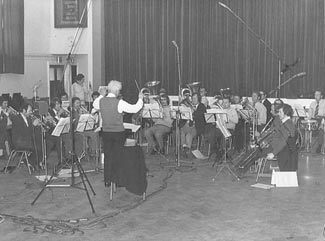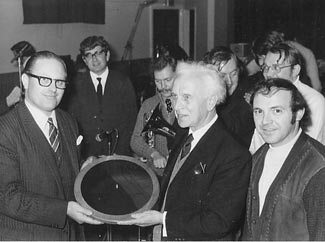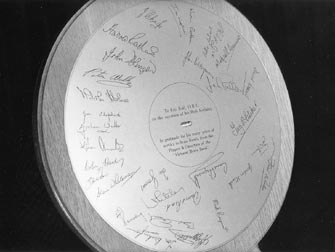|
A History of the Virtuosi Brass Band of Great Britain -
part 2
Fred Waters presents his second part of his definitive history
of an unique brass band - the 28 of the best players in the land,
who came together to perform on nine LP's and one concert in the
heady days of the 1970's called the Virtusoi Brass Band of Great
Britain.
Why the Recordings were so special in the 1970s?
To create technically great recordings, in addition to expert musicians
and musical directors of the highest calibre, it is also necessary
to have both an acoustically suitable venue and a world-class recording
engineer, supported by a dedicated production team. John Berryman
and Fred Waters were fortunate in being offered the Brighouse &
Rastrick bandroom, at that time the Rydings Hall in Brighouse, which
was acoustically good, ideally situated and was available at a reasonable
cost (important as, with the exception of the Band’s only
public concert, no external funding or sponsorship was ever sought).
The recording engineer for all nine recordings was Bob Auger who,
at that time, was the UK chief recording engineer for RCA records.
Before appointing Bob, John, Fred and Tom Beckingham (our lead producer)
discussed with him the shortcomings in recording quality of brass
band LP's available at that time. The decision to appoint him was
not difficult when he indicated how the latest “close mic”,
multi-track recording techniques used when recording symphony orchestras
would bring a realism and presence to brass band recordings like
never before, always providing ALL the individual players were good
enough to withstand such close microphone scrutiny. In our case
this was clearly not going to be a problem.
The Music Repertoire
In the 1970s there was much debate about new music being introduced
into the brass band repertoire by such fine bands as Grimethorpe
Colliery under the direction of Elgar Howarth – “Grimethorpe
Aria” particularly comes to mind. It was therefore decided
as a matter of principal to record only what was considered at that
time to be traditional brass band music, although this would not
preclude the commissioning of new works as long as they were not
written in an avant-garde style.
Nevertheless, after the Band had become well established, as an
experiment, a new piece involving splitting the players into two
“half bands” and sitting them in a diamond formation
was tried. However, it was quickly abandoned as the musical content
(using the term in its broadest sense), was unanimously felt to
be unacceptable to all but the most adventurous brass band listener.
Because no financial sponsorship was ever sought the music chosen,
while to a degree being influenced by the tastes of the producers,
was mainly selected with a view to attracting sufficient record
sales to guarantee the revenue needed to finance the next record.
Financial constraints were always severe and anyone who was unfortunate
enough to be exposed to the dire artwork of the first two LP record
sleeves would have seen one of the effects of cash shortage! Another
reason why mainly traditional items familiar to all the players
were recorded was due to the limited rehearsal time available at
each recording session.
However, new compositions and arrangements for the Band were commissioned,
mainly from Eric Ball and Frank Bryce. These were highly successful,
not least of which were a soprano duet featuring Brian Evans and
Peter Roberts, an euphonium duet starring Trevor Groom and John
Clough and a tenor horn solo specially written for Gordon Higginbottom.
In all a total of eleven new items were featured on the nine LPs
and a further item, a trombone trio featuring Stan Priestley, Terry
Hext and Ian Copland, was performed for the first time at the Band’s
1979 public concert.
It was decided to include at least one traditional test piece on
every LP but unfortunately test pieces written prior to the inclusion
of percussion on the contest stage, e.g. “An Epic Symphony”,
“Lorenzo” and “Oliver Cromwell”,
had no percussion parts written by the composers. Fortunately this
was overcome by the founding musical director Eric Ball who, with
amazing speed, wrote suitable parts, some of which are still in
use today.
An unusual departure from the traditional brass band music repertoire
was adopted for the Band’s seventh recording session in October
1975. Here it was decided to produce an LP containing, with the
exception of the test piece “Three Figures”,
only items from the classical orchestral repertoire and mainly from
the pen of Sir Edward Elgar, two of which being special arrangements
written for the Band by Eric Ball.
The Recording Sessions

To bring together 28 players, all of whom were heavily committed
to their own (championship) bands, twice a year was difficult and
the only way possible was to hold two three hour recording sessions
on a Monday. Even this placed exceptional demands on the players
from Black Dyke as Monday was one of their rehearsal nights. Being
able to perform all day at the level that they did, having on numerous
occasions not arrived back in Queensbury from an engagement “down
South” before the early hours of Monday morning, followed
by a two hour rehearsal after a full day’s recording, demonstrates
their consummate musical skill, professionalism, dedication and
physical fitness.
The first recording session in March 1973 was truly a revelation.
Eric Ball quickly settled the new Band down into a cohesive ensemble
and such was the musical rapport between the players that they completed
the first LP with sufficient time to spare that, having raided the
Brighouse music cupboard, the Band went on to produce a second LP
of marches in the last hour of the day! Admittedly there was a certain
informal moving around of cornet players, not least of which was
Peter Roberts migrating from the 3rd cornet chair to take over from
Brian Evans on soprano cornet on at least one of the marches. On
another track the front and back row cornets swapped parts but such
was the strength of the back row that one would never know listening
to the record, although it was suggested that one or two of the
front row did have a slight problem with their bottom lips! All
this demonstrates the immediate camaraderie established between
the players, although their professionalism never let frivolity
creep in.

The second recording session held on 29th October 1973 was just
two days before Eric Ball’s 70th birthday and to commemorate
this all the Band and producers signed a mounted “LP” and
this was presented to him by FW at the end of the recording day.

On only one of the Band’s recording sessions did the carefully
laid plans nearly collapse when, having set up the microphones,
control room etc. on the Sunday evening Bob Auger arrived at the
Rydings Hall at 9.00am on the Monday morning to discover that all
the microphones had been stolen during the night. Here again the
benefits of employing the “best in the business” paid
off. After calling in the Police Bob set about acquiring a complete
replacement set of studio quality microphones (from who knows where),
and the Band commenced recording just thirty minutes after the
scheduled start time. No doubt this was the first time that the
players had had their playing overseen by the West Yorkshire CID!
Thereafter there was always a night watchman sleeping in the Hall
over the Sunday night who, being a well built young euphonium player,
was delighted to receive his fee in the form of a one-to-one master
class from Geoffrey Whitham in a room in the Black Bull Hotel.
It must have done this young player some good as he finished up
playing euphonium with Morris Motors under the baton of HM.
Fred Waters will always remember “an interesting incident”
at the first of the two recording sessions conducted by Harry Mortimer.
One of the items was a new work by John Golland for three cornets
and three trombones entitled “Relay”. As the
music was in manuscript and untried John was invited to attend the
recording in case of any problems. This he did and as expected there
were the inevitable very minor problems which required a few minutes
rehearsal by both the six soloists and HM. Unexpectedly John stepped
forward and suggested to Harry that if he had any problems conducting
this piece he, as the composer, would be delighted to conduct the
Band himself. When Harry had recovered his composure he conducted
the piece without a hitch and the item was laid down in a single
“take”. This experience confirmed the wisdom of the
original decision to record behind closed doors (Geoffrey Whitham
excepted of course!).
The final memorable experience occurred when the Band commenced
recording its final LP in October 1976 with Stanley Boddington at
the helm. For the initial balance test Stan put up the Quick March
“Steadfast & True”, started the Band off
and then went down to the control room to listen to the balance
set-up. With Harvey Whiteley providing a rock steady beat on percussion
and with Gordon Higginbottom being ideally situated in the middle
of the Band to make hand signals (he always maintained that he was
indicating 2nd time bars!), the Band completed the playing of the
march without a note out of place.
When Stan commented that he could not improve on either the balance
or the Band’s performance the first track of the day was “in
the can” without the assistance of a conductor! The final
memorable event that day, also involving Gordon Higginbottom, was
in connection with the first ever recording of the tenor horn solo
“September Fantasy” which Eric Ball had specially
written for him. This piece is seven minutes long and he played
it flawlessly in one take, so much so that he received a well deserved
ovation from the other members of the Band. Unfortunately, while
he was holding the final sustained top note Bob Auger ran out of
tape! Although this slight problem was overcome in minutes, Gordon’s
comments are unfortunately unprintable!
Lunch was always provided for the players at the Black Bull Hotel
in Brighouse which, at that time, served a splendid steak &
kidney pie. The players always lunched on this dish as experience
after lunch on the first recording session clearly indicated that
if “more robust” items were left until after the steak
& kidney lunch they seemed to then go with that something extra.
Just listen to the final movement of “Le Roi d’Ys”
on CD No. 4.
One thing is sure, those privileged enough to be at any of the
Band’s recording sessions will never ever forget the experience.
Record Production Problems
Long gone are the problems associated with the manufacture of vinyl
LPs that resulted from the 1973 oil crisis and which persisted until
the introduction of CDs.
These difficulties largely stemmed from the major record pressing
companies (we used EMI and later Polygram), trying to offset the
massive increases in the cost of vinyl – an oil by-product,
by halving the thickness of their records and using recycled vinyl
granules. Sadly this resulted in a “snap, crackle and pop”
playing surface and a warp in virtually every record. Quality control
problems reached a critical point for Fred and John when the first
production pressings of LP No. 4 were received just one week before
the 1974 National Finals at the Royal Albert Hall. As it was essential
to have these for sale on the Virtuosi trade stand at this
prestigious event it was devastating to discover that the bulk of
the pressings were reject. EMI’s response was to repress them
immediately and these were better but they were still not good.
That is when the pressing company was changed to Polygram although
it is only fair to say they too had pressing quality problems.
There is some substance to the often expressed view that recordings
made using magnetic tape (analogue recording) and reproduced on
LPs had a warmer and truer sound. However, the problems in editing
and maintaining LP manufacturing quality were such that when digital
recordings (CDs) were introduced any small differences in sound
texture (which most peoples’ audio systems would not detect
anyway), were more than outweighed by the virtual elimination of
production problems and the improved accuracy of the editing process.
Fred Waters
(February 2004)
The copyright of this document subsists with the author and must
not be reproduced complete or in part in any form without prior
written permission
 back to top
back to top
|

